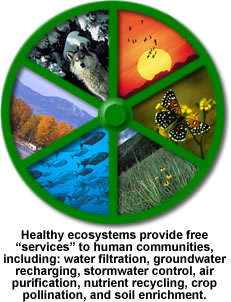
 |
| Home > Policy Issues > Green Infrastructure > Introduction | ||
IntroductionStates wouldn’t think of building their “gray” infrastructure – including roads, sewers, and utility lines – without going through a planning process to ensure that the project in question would work well, meet real needs, and complement existing structures. Yet, conservation efforts have historically proceeded in a somewhat haphazard fashion, responding to ecological emergencies, only considering a single species or resource at a time, and not coordinating with similar initiatives. |
||
|
||
Ideally, green infrastructure programs consolidate ecological information across multiple landscapes and on different scales, and use it to coordinate, direct, and streamline conservation efforts, maximizing the benefit from limited funds. Green infrastructure planning considers conservation values along with land development, growth management, and built-infrastructure planning, and provides a well-designed framework for both conservation and development. By considering ecological needs in the context of human activities, and protecting the green infrastructure network using a range of approaches (including acquisitions, property protection agreements, conservation easements, and incentive-based programs), green infrastructure programs benefit everyone. Native plants and animals, unique and significant landscapes, water reserves, and other natural resources are better protected. Conservation funds are better spent and conservation programs are more effective. Businesses (including developers, agriculture, ranches, and forestry) know which areas can support full or limited private uses, which are for public use, and which require the highest degree of conservation stewardship. Local and tribal governments understand the broader context of, and receive support for, their planning and conservation efforts. Residents and visitors enjoy more opportunities for outdoor recreation, higher property values, healthier communities, potentially lower costs for public services and built infrastructure, and cleaner air, water, and land. This web site contains tools to define and protect your state’s green infrastructure network, including a sample bill, talking points, press clips, a fact pack, links, and other background information. We may have other useful materials on this subject, which are not posted on our web site. Please feel free to contact us at info@serconline.org or call our office in Madison, Wisconsin, at (608) 252-9800. If you’ve used this site and found it helpful or, if you have suggestions about how it could be made more helpful, please let us know. Feel free to use the sample bill text included here in your state. If you do, please notify us. |
||
| Sources: (1) Benedict, Mark A. and Edward T. McMahon. “Green Infrastructure: Smart Conservation for the 21st Century.” Renewable Resources Journal 20.3 (Autumn 2002). Sprawl Watch Clearinghouse. 22 September 2004 <http://www.sprawlwatch.org/greeninfrastructure.pdf>. |
||
| This package was last updated on September 22, 2004. |
